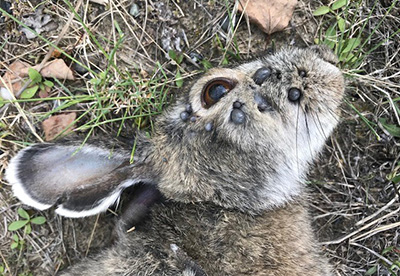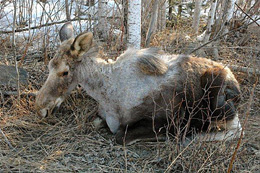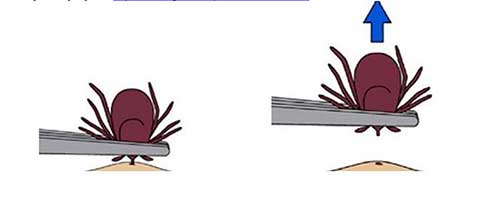Alaska Fish & Wildlife News
July 2018
Ticks the Focus of New Research in Alaska

Researchers studying ticks in Alaska are seeing more of the small arachnid parasites than ever before.
“I’ve been getting multiple calls some days about ticks on hares, squirrels and dogs,” said Kimberlee Beckmen, a veterinarian with the Alaska Department of Fish and Game, based in Fairbanks. Beckmen said the past two years are the busiest she’s seen since she began monitoring ticks. That’s also true for State Veterinarian Bob Gerlach, with the Department of Environmental Conservation in Anchorage. Alaskans are submitting ticks they find to the researchers: Beckmen is focusing on ticks found on wildlife, and Gerlach is focusing on ticks found on pets, people and domestic animals.
“Last year Gerlach got more than 50 ticks in the summer,” Beckmen said. “He told me he was getting even more ticks this year, and I know I have.”
It’s extremely important that ticks are sent to the veterinarians with some useful information, and sent so they don’t arrive crushed, dried-out, or sandwiched between two pieces of tape. Clear directions for removing ticks and submitting samples are provided in this article.
A new study – and ongoing research
The state veterinarian and ADF&G wildlife veterinarian have been monitoring Alaska’s native tick species, and the more recent introductions of non-native ticks. They also monitor tick-borne diseases such as tularemia. A new project will expand monitoring and include some active searches for ticks.
The new study is a collaborative effort between the University of Alaska (Anchorage, Fairbanks and Southeast), Fish and Game, and the Office of the State Veterinarian. UAA Professor of Environmental Health, Micah Hahn, will lead the project, which includes setting up field sites in several parks in Anchorage and the Kenai Peninsula to look for ticks on wildlife. Dr. Beckmen will work with Fish and Game biologists to collect any ticks that might be found on wildlife that are captured during research and management projects. Public outreach will provide instructions for Alaskans to submit ticks they find on themselves or their pets through the Office of the State Veterinarian. UAF professor of veterinary pathology, Dr. Molly Murphy, will test the ticks for pathogens that can carry diseases such as tularemia, Babesiosis, and Lyme disease.
UAA Professor of Computer Science and Engineering Frank Witmer will use information on tick habitat preferences to develop a model to predict where in Alaska non-native ticks could survive based on climate and land cover. This will help target high risk areas for tick monitoring, and for land use and wildlife management practices that can help prevent the emergence of tick borne diseases; and help veterinarians and medical professionals better understand who is at risk for tick borne diseases and when to test patients for these diseases.
The project is funded by Alaska INBRE, the IDeA Network of Biomedical Research Excellence, a statewide research network affiliated with the University of Alaska system, the Alaska Native Tribal Health Consortium, and the Southcentral Foundation.

The project summary states that the number of human cases of tick-borne disease in the United States has tripled over the past two decades, and the geographic range of many tick species has expanded substantially due to changes in climate, land use, and human and animal movement.
Ticks: disease and stress
“There’s a worldwide concern about tick-borne diseases, and ticks are surviving further north,” Beckmen said. “We still have Alaskans – including veterinarians – who don’t think there are ticks in Alaska; they just don’t believe that we have them. We have always had endemic wildlife ticks, and increasingly dog ticks are an issue up here.”
The squirrel tick is native to Alaska and is found on hares and voles, as well as its namesake host. This tick can transmit tularemia, a bacterial disease which can spread from hares to pets and people. In May of this year Beckmen identified hares with tularemia in the Fairbanks area. The disease has been confirmed in at least two sick dogs, also in this area. In 2017, two pet cats in Fairbanks died from tularemia. A case of Lyme disease in a dog, acquired from a tick bite on the Kenai, has also been diagnosed in Alaska.
Two non-native ticks have become established in Alaska in the past decade, the brown dog tick and the American dog tick. The brown dog tick prefers indoor environments, especially kennels and homes. The ticks have been found in all over the state but most frequently in Fairbanks, North Pole, Anchorage, Eagle River, Bethel and Valdez.
Non-native ticks are repeatedly arriving in Alaska on dogs and people returning from trips to the Lower 48. Because ticks can survive in Alaska once they are introduced, it’s important that people use a tick preventative and check their pets and themselves for ticks if they travel. Beckmen also recommends treating pets with tick repellent that also kills ticks quickly, before disease transmission can occur. Several very effective products are available and easily applied to the skin along a dog’s back which will work for several weeks. Beckmen said flea collars are not very effective but Seresto is an example of an effective tick collar.
A major concern right now is the potential arrival of a moose parasite, the moose winter tick. Wild mule deer, not pets, or imported cattle, bison, horses or elk, will be the most likely vector. Mule deer are not native to Alaska, but in recent decades they have pushed their range further north and west into the Yukon and Eastern Alaska. A mule deer was hit by a car and killed near Fairbanks in 2017, and mule deer have been reported elsewhere in eastern areas of the state.

“Almost half of the mule deer that were surveyed in the Yukon were carrying moose winter tick,” Beckmen said. “Those deer are now coming in to Alaska, and if they drop ticks in areas there are moose, they will infect our moose population.”
This tick is a serious parasite that can kill moose and cause moose population declines. Moose calves are especially vulnerable. The ticks cause the moose to itch and scratch during winter, rather than spending time foraging or resting and lose substantial amounts of hair. A moose with typical infestation can have tens of thousands of ticks and experience severe blood loss. Blood loss, heat loss, spending more time scratching than foraging, combined with the hardships that moose experience in winter, takes a lethal toll. Beckmen said moose often die in a state of starvation in mid to late winter, when the hair loss as well as the ticks are seen on the animal, which is why they call it winter tick. The tick was originally found in areas like Alberta, Canada, but it’s moving north as the environment is warming up farther north. It is also a major cause of mortality and declines in moose populations in the upper Midwest and Northeastern US.
The tick is a one-host tick and has a seasonal life cycle. The adult ticks drop off moose, elk and deer in the spring, in April. The females lay eggs in the summer, they hatch, and the larvae crawl on vegetation and then get onto moose in the fall, usually in September. They wait on vegetation at the ideal height to get on the front legs of calves and yearlings as they pass by.
An incident in mid-June, 2018, in Kodiak offers an example of another vector for ticks – birds. Robin Corcoran, a wildlife biologist with the Kodiak National Wildlife Refuge, reported that a seabird, a Northern Fulmar, was found in a parking lot in the city of Kodiak covered in ticks. She wrote, “Although we frequently encounter birds with lice this is our first experience with ticks, which we believed were very rare in Alaska. It was a massive infestation - estimated 300 ticks on this one bird.”
Send ticks – with information!
“Now with a funded study, we do want to collect addition ticks off wildlife: small mammals, squirrels, voles, and in particular ticks on moose or deer,” Beckmen said. “It’s really important to get the information about where it came from and the other specifics to understand the disease dynamics and risks.”
That includes what kind of animal the tick was on (the host), the location of the animal, circumstances involved in the collection, and contact information.
Bob Gerlach, the state veterinarian, will be the contact for ticks found on people, pets and domestic animals. Although ticks go to either Gerlach in Anchorage or Beckmen in Fairbanks, the same sample submission information is needed, the packaging method is the same and all the ticks eventually end up in the study.

“This is a cooperative effort,” Beckmen said. “We need the public and we want them to participate, but we need the efforts to be rewarded with information that is scientifically useful.”
If you find a tick on your pet, you can remove it yourself or take your pet to a veterinarian. It’s easy to remove a tick. You don’t need to torture ticks with oils, solvents or heat (heat causes the tick to regurgitate material back into the wound and should be avoided). Use fine pointed tweezers, grasp the tick close to the skin, apply firm, steady tension straight out and in just a few seconds, it will release. Don’t squash it. Any fluids released are infective too so you don’t want to get any of the fluid in a cut or on your skin. Wash the wound and your hands afterward.
Put the tick in a small unbreakable container. It is best if it is in a small amount of ethanol (vodka works in a pinch if we know that is what you used) but not rubbing alcohol. It can also be sent by itself in an unbreakable container, with no wadding or tissue because that dries it out. The packaged tick can also be delivered to a local Fish and Game office and staff can send it to Beckmen in Fairbanks.
It is critical that some information is provided as well. You can download a “sample submission form” from the Fish and Game website. This form is used for a wide variety of samples – so note on the form this is a tick submission.
Beckmen said a pathologist can look at DNA in the tick sample to determine what diseases the tick might carry. “It’s more specific and easier to detect the pathogen directly in the tick than the antibodies in a person,” she said.
The sample submission form – with contact information for both Gerlach and Beckmen
Tularemia Fact Sheet for Pet Owners (PDF 42 kB)
http://www.adfg.alaska.gov/static/species/disease/pdfs/tularemia_pet_owners_fact_sheet.pdf
Wildlife Health & Disease Surveillance Program: dfg.dwc.vet@alaska.gov
Wildlife Health Information Phone: 907-328-8354
Alaska State Veterinarian office: 5251 Dr. MLK Jr. Ave., Anchorage, AK 99507
ADF&G Wildlife Veterinarian address: 1300 College Road, Fairbanks, AK 99701
The mention of product brands serves as examples and is not an endorsement.
Riley Woodford is the editor of Alaska Fish and Wildlife News and the producer of the Sounds Wild! radio program.
Subscribe to be notified about new issues
Receive a monthly notice about new issues and articles.
